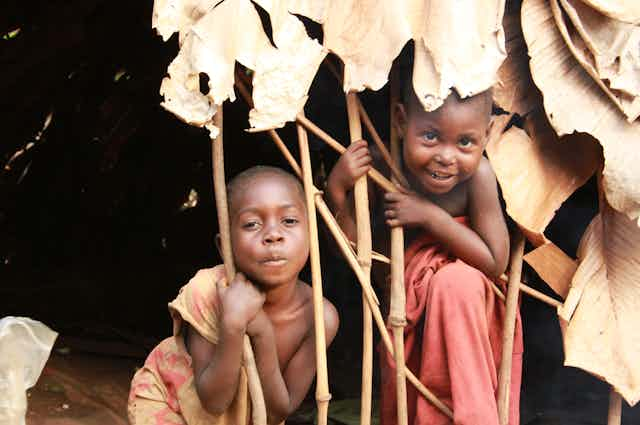When Eteni, a 13-month-old baby living in the dense rainforests of Congo, attempts to cut freshly hunted meat with a sharp knife, no one interferes. In fact, Eteni can often be found playing with sharp tools and imitating her nine-year-old aunt, Bwaka, who is already efficient at digging wild yams and cutting bush meat with her machete.
As Eteni and Bwaka interact with each other and other community members, they provide a glimpse into how Mbendjele hunter-gatherer children acquire skills that are crucial for survival in the forest.
I’m an evolutionary anthropologist and I’m interested in how hunter-gatherer children learn because these observations might tell us how humans transmitted skills and knowledge before the dawn of agriculture. By observing hunter-gatherers as they share knowledge about the world around them today, we get a glimpse of how human culture developed in ancient hunter-gatherer communities.
Human culture is unprecedented because it is cumulative. We build on our existing stock of skills and information, recombine them and generate new ones. This process, over time, results in complex phenomena like the internet. At the beginning, there was language and speech, then came the written word and printing, radio communication and telephone, then computers and the internet. But culture only accumulates and evolves over time if information can be passed on accurately.

In our study, my colleagues and I watched more than 100 video recordings from time I spent with the Mbendjele BaYaka Pygmies to understand how hunter-gatherer children develop skills such as using knives, caring for infants, and gathering wild plants when they are as young as three years old.
Most infants and toddlers learn by freely exploring their environment, observing and copying others. This way of learning through imitation is a great way of transmitting skills accurately and likely explains how the earliest concepts and processes were first learned and communicated among ancient hunter-gatherer groups.
Teaching is another great way of ensuring information is passed on correctly. But compared to the years of formal education children receive in societies like the UK – where a strict hierarchy is enforced between them and the teacher – teaching is rare for hunter-gatherer children like the Mbendjele. Hunter-gatherers encourage children to be self-reliant and are less likely to intervene in their actions, because independence is crucial in their environment where a person needs to look for food each day.
Does this mean that teaching isn’t necessary? Not at all. Our observations suggest that teaching in humans is universal and has evolved as cultures have evolved. When skills and knowledge become more sophisticated – as information and complex interdependent relationships stack up – learning through being taught becomes crucial. You can’t learn mathematics by simply observing someone solving problems after all.
Among the Mbendjele today, teaching is reserved for transmitting abstract information, like how to behave around others. Rather than giving direct instructions, hunter-gatherer teachers often create learning opportunities and monitor the child’s activity. For example, I watched a teenage boy learn how to share food equally among the camp as the adult monitoring him only intervened to give feedback.
The value of childhood and play
As humans, we have an unusually long childhood period. On average, we spend the first 18 years of our lives being dependent on others for food. In contrast, chimpanzees are nutritionally self-sufficient immediately after weaning, at five to six years of age. Many agree that childhood has evolved in humans to allow necessary time to develop the complex skills needed for hunting and gathering.

The accurate transmission of these skills and knowledge through imitation and being taught allowed human culture to evolve. In most societies today, schools serve this purpose. But for thousands of years, humans didn’t have formal schooling. In traditional societies like the Mbendjele, children spend most of their time in playgroups. As these groups are composed of children of different ages, they provide an environment for children to learn from each other.
Practising skills or acquiring knowledge in playgroups accounted for over 60% of the learning we saw in our study. In one of their plays, Mbendjele children imitate the forest spirit rituals of adults. During these rituals, women sing together while clapping their hands to beckon forest spirits into the camp. Men, who claim to have captured spirits while walking in the forest, cover themselves in wild leaves in a secret path, and later arrive in the camp to perform ritualistic dance. By imitating these rituals in mixed-sex playgroups, hunter-gatherer children learn gender roles and cultural practices.
Growing up in Turkey, I feel fortunate to have had a childhood where I got to play in the streets with other kids. When I’m with the Mbendjele children, I admire their freedom in playing outdoors and their creativity in turning the forest’s different materials into something to play with.
I think we have a lot to learn from hunter-gatherer childhoods. Not only do they shed light on how culture evolved, but they can inspire us to reimagine how children are taught – something people seem surprisingly incurious about elsewhere in the world.

